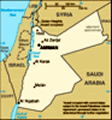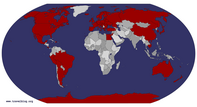Advertisement
Published: February 21st 2023
We have been back just over three weeks, but my mind keeps wandering back to the epic landscapes and vivid history of our family trip to Jordan and Egypt. Over 16 days, we completed a whirlwind tour of both countries seeing many of the most famous sights and leaving us eager to return and see more of both countries in the future. On a bright note, Riley did really well on the trip with almost no other kids to interact with! He made friends with our fellow tourists over the two weeks.
After a gruelling 24 hour set of flights from Vancouver to Calgary to Frankfurt to Amman, we arrived late in the day on January 7, were greeted by a local guide and taken to our hotel. The next morning, we were up bright and early ready to see the sights. On our first day, our guide, Adnan, introduced himself and his country. We learned of the rapid population growth in Jordan primarily from refugees from neighbouring countries, the water scarcity that continues to challenge the nation, and the problematic environmental issues. Adnan brought his son, Mohammed, on part of the tour so Riley would have someone of similar
age to paly with. We started our first guided stop in Jerash, a partially restored Roman ruin containing temples, gateway arches, forums, tombs and mosaics. We were particularly impressed by the scale of the ruins. We also got a crash course in the constant attempts by locals to sell items to tourists (by far, the most challenging part of the trip). Pretty soon, we learned to say ‘la’ (no) to everything whether we were interested or not. We were very careful where we shopped to avoid being swamped. Our next stop was Ajloun Castle where we entered the drawbridge and explored the passages all the way to the rooftop battlements. Riley particularly enjoyed the huge amount of cats that had made the castle their home. This castle was constructed in the 12
th century by the Ayyubids.
The next day, we travelled to Madaba to see a historic mosaic map of the Holy Lands in the 6th century and then to the church on Mount Nebo that contained additional mosaics, famous in this area. Mount Nebo is also the resting place of Moses. After 40 years of wandering in the desert, Moses died on Mount Nebo at the age of
120, within sight of the Promised Land. The rest of the day was spent heading south with a detour to see Montreal / Shobak Castle, a Crusader castle built in the 12
th century that protected the Kings Highway. After a walk up to the castle walls, we entered the castle and explored the many cavernous rooms. We arrived in Wadi Musa in the late afternoon. As a bonus excursion that evening, we had selected to enter Petra by night. The canyon known as the Siq was lit up with candles and we got to see the Treasury of Petra by candlelight. There was also a light show (almost every monument we saw had a kitschy light show at night but we avoided the rest). Bar the occasional tourist with a flashlight phone, the undisturbed candlelit walk into and out of Petra was serene and felt magical.
The following day, we got to fully explore Petra (in the daylight). We saw the Djinn Blocks, Obelisk Tomb and then entered the Siq. There was a historic water aqueduct that followed the walls all the way down the Siq. The colours of the rocks were highlighted by the many levels of strata
to the top of the Siq above us. We could see a sliver of light at the end of the Siq, and then a glimpse of the Treasury. Then we joined the masses of tourists before the Treasury and the many Bedouin salesmen. I opted to leave the tour group at this point as they moved at a leisurely pace. I decided to hike up to the High Place of Sacrifice which gave a bird’s eye view of the tombs at Petra. I found the sacrificial alter stained red. I came down the long way with barely a tourist in sight. The Bedouins I passed here were respectful, perhaps offered for me to join them for tea. But I was on a mission. I gave some Dinar to some of the children we passed who seemed overjoyed with their good fortune. I passed the Lion Fountain and the Garden Temple, then stopped for tea with some boys at the Garden Tomb. I entered the Coloured Triclinium and the Tomb of the Soldier, then passed by the Renaissance Tomb and Broken Pediment Tomb (under scaffolding) on the way through the Wadi Farasa to the Great Temple. I caught up with the
group there. We spotted the Qasr al-Bint which was the largest intact free standing temple at Petra. We stopped for a bite of lunch, then decided to make the trek up to the Monastery. Some of our friends took donkeys. It was a long hike but Riley did exceptionally well. When we reached the top, he even did an extra hike to reach the highest spot with great views of the Monastery. I also did an extra hike out to the viewpoints where you could see dozens of miles to the west. After we hiked back down, we met up with Paul, Margaret, Louise, and Tony, and decided to hike the northern ridge to see the Winged Lion Temple, Blue Church, Byzantium Church and in the distance, the Nymphaeum. We got up close to the Royal Tombs, starting at the Palace Tomb, Corinthian Tomb, Silk Tomb, and the Urn Tomb. We had a great view of the Nabateam Theatre, cut right into the rock face and the Tom of ‘Unayshu on the Street of Facades. Ann and Riley made some souvenir purchases and then we passed the Treasury again on a rush back up through the Siq. We made it
to the tour bus with seconds to spare. That evening, after dinner, I made my way back to the entrance of Petra and visited The Cave Bar (the oldest in the world, the cave, not the bar!). They had taken a Nabatean tomb and converted it into a trendy bar and café. It felt like a long hike back to the hotel that evening after all the hiking through the day. Luckily, I’d had a few beers to reduce the aches.
After our day at Petra, we had was another spectacular day as we were transported to Little Petra, a former camel market meant to house visiting traders on the Silk Road. Like Petra, it was built over 2000 years ago. It contained a smaller Siq entrance, a Triclinium, Painted House (a tomb with well preserved wall paintings) and a high lookout point. I left the group to make a bonus stop at Beidha / Bayda, a major Neolithic archaeological site form the 11
th millennium BC (13,000 years ago) – even with all the historic sites we were visiting, this small village was the oldest by far. We still had miles to travel that day as we headed south
into the Wadi Rum desert. Our first stop was the Ahmed Zawayda Camp where we got in jeeps that took us into the Wadi Rum desert. I sat with Nick and Sammy on the patio and looked out at the Seven Pillars of Wisdom. This section of the Wadi Rum had appeared in many movies and shows including Lawrence of Arabia (which we watched before we left on the trip), Star Wars, Dune, The Martian, Moon Knight and more. We got to climb the sand dunes, see ancient (?) petroglyphs, meet a Bedouin tribe with their camels, and see a funny rock with a likeness of Lawrence of Arabia (?!). We stayed the night in a tent at the Hasan Zawaideh Camp. We watched the sun set over the mountains. The next morning, we woke early to ride camels into the desert to see the sunrise. Riley had his own camel and did really well.
It was time for the a long drive back to Amman (with no stops). We convinced Trevor and Chrissie (who were staying at the same hotel with us) to get Ubers to the Amman Citadel. We all had a great walk around the Citadel
which had contained fortifications since 1800 BC. The current buildings at the site are the Temple of Hercules (1st century BC), a Byzantine church (3
rd century AD), and the Umayyad Palace (7
th century AD). The best feature was the view out over the City of Amman. Afterwards, we found the local pathway down to the Roman Amphitheatre and The Hashemite Plaza. We stopped at the Roman Nyphaeum (fountain), then plunged into the local souq / bazaars. We started at the Fruits and Vegetables souq, then moved through the Clothing, Home Goods, and Jewellery sections. We saw the Grand Husseini Mosque and stopped for Kunafa at Habibah Sweets. We decided to go to a Chinese restaurant for dinner which did not look far on the map but was an uphill climb all the way and included a dead-end when a local access door was shut for the night. Fortunately, Trevor and Chrissie were good sports and we all agreed it was worth it after we had dinner at Abu Khalil Chinese Restaurant near Rainbow Street. They had the best service, friendly staff, cold beers and delicious Chinese food (with white rice and soy sauce for Riley). We took Ubers back to
the hotel afterwards and called it a night.
Another long drive and tour the next day to some of the desert castles in eastern Jordan. We stopped at Qasr Al-Kharranah (which provided traders with a cool safe location to stay), Quseir ‘Amra (a hunting lodge and bath house with illicit frescoes, and Al-Azraq Castle (a large basalt castle with swinging stone doors). Another long drive to the Dead Sea so we could go swimming / floating. Some of our friends tried the ‘healthy’ black mud but we passed. This point in the Dead Sea is over 400 m below sea level and the salt concentration is so high that it is difficult to stay upright because the buoyancy makes you float. That evening, back in Amman, we went to a shopping mall and Riley found a kids amusement park. It was the most kids we saw in one place on our entire trip.
While some of our friends had a one hour flight to Cairo, Egypt the next day, we took a two hour flight to Jeddah, Saudi Arabia, then a layover and another two hour flight to Cairo. Quite bizarre. Our friends were sending us photos of
themselves with drinks on the patio while we were still in transit (to the same hotel). The one bonus was that we got to visit a new country and fly over the Muslim holy site of Mecca.
Advertisement
Tot: 0.355s; Tpl: 0.015s; cc: 9; qc: 42; dbt: 0.0922s; 1; m:domysql w:travelblog (10.17.0.13); sld: 1;
; mem: 1.1mb




















